Roscoea
| Roscoea | |
|---|---|
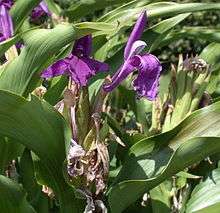 | |
| R. auriculata | |
| Scientific classification | |
| Kingdom: | Plantae |
| Clade: | Angiosperms |
| Clade: | Monocots |
| Clade: | Commelinids |
| Order: | Zingiberales |
| Family: | Zingiberaceae |
| Genus: | Roscoea Sm.[1] |
| Species | |
|
See text. | |
Roscoea is a genus of perennial plants of the family Zingiberaceae (the ginger family). Most members of the family are tropical, whereas Roscoea species are native to mountainous regions of the Himalayas, China and its southern neighbours. Roscoea flowers superficially resemble orchids, although they are not related. The flowers of Roscoea have a complicated structure, in which some of the showy coloured parts are not formed by petals, but by staminodes, sterile stamens which have evolved to become like petals. Some species are grown as ornamental plants in gardens.
Description
Roscoea is found from Kashmir through the Himalayas to Vietnam, extending northwards into China. There are up to 22 recognized species, of which 8 are endemic to China.[1][2] Typically they grow in grassland, in screes or on the edges of deciduous woodland at heights of 1,200–5,000 metres (3,900–16,400 ft), coming into growth at the start of the monsoon season.[3]
Species of Roscoea are small perennial herbaceous plants. They die back each year to a short vertical rhizome, to which the tuberous roots are attached. Like many members of the Zingiberales (the order to which the gingers belong), Roscoea has "pseudostems": structures which resemble stems but are actually formed from the tightly wrapped bases of its leaves ("sheaths"). The leaves are without a stalk (petiole). Lower leaves may consist solely of a sheath; upper leaves have a blade which is free from the pseudostem, and is oblong or lanceolate (i.e. considerably longer than it is wide).[2] The relative number of bladeless versus complete leaves is one distinguishing feature of the two clades into which the genus is divided.[4]
The flowers are borne in a spike at the end of the pseudostems. The stalk (peduncle) bearing the flowers may be long, so that the flowers appear well above the leaves, or short, so that they appear between the upper leaf sheaths.[5] Like other members of the ginger family (Zingiberaceae), Roscoea flowers have a complex structure (superficially resembling that of an orchid,[6] although they are not related). Each flower has a tube-shaped outer calyx, which is split on one side and ends in two or three teeth. The petals are joined together at the base, and then divide into three lobes. The central lobe is upright and usually forms a hood; the two side lobes are narrower than the central one. The flower then has what appear to be three inner petals, which are actually formed from four sterile stamens (staminodes). Two lateral staminodes form what look like upright petals, often also hooded in shape; two other staminodes are fused together to form a prominent central "lip" or labellum.[2][Note 1]
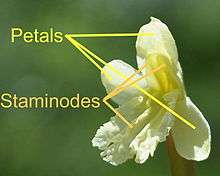
The single fertile stamen has a short filament bearing a cylindrical anther. The connective tissue between the anther's two pollen sacs extends outwards at its base to form spurs. The ovary has three "cells" or locules, eventually producing many small arillate seeds. The single functional style extends upwards through a grove in the stamen to appear above its top.[2][7]
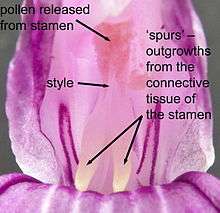
Flower structure and pollination
The orchid-like flowers with a long floral tube appear to be an adaptation for pollination by long-tongued insects specializing in this type of flower.[8] The design of the flower suggests that the lip acts as a landing platform and that if a pollinator puts its head into the flower in order to obtain nectar, it will push down on the spurs on the stamen, causing the anther (and the stigma which is held in front of it) to bend over and contact the insect's back.[9] However, in the only two species so far studied in detail (R. cautleyoides and R. humeana), the actual pollinators were short-tongued pollen-collecting bees.[10] In at least one species, R. schneideriana, it has been shown that if cross-pollination does not occur, the stigma bends over towards the anthers, thus effecting self-pollination.[8] One suggestion is that although the original pollinators may have been long-tongued insects, these are now absent from at least some of the areas where Roscoea occurs, so that the genus has been able to survive in its alpine habitats through the presence of generalist pollinators and self-compatibility.[10]
Taxonomy
Roscoea was named by the English botanist James Edward Smith in 1806. The type species is R. purpurea.[1] The name honours Smith's friend William Roscoe, the founder of the Liverpool Botanic Garden[11] (remnants of which can now be found at Croxteth Hall). Roscoe is known to have been interested in "gingers" (Zingiberales) and to have grown a number of collections of this group of plants.[12]
Evolution and phylogeny
A 2002 classification of the Zingiberaceae family, based on molecular phylogenetic analysis, placed Roscoea in the tribe Zingibereae, subfamily Zingiberoideae. It was most closely related to the genus Cautleya, and then to Rhynchanthus, Pommereschea and Hedychium.[13] The Zingiberaceae family is mainly tropical in distribution. The unusual mountainous distribution of Roscoea and the closely related Cautleya may have evolved relatively recently as a response to the uplift taking place in the region in the last 50 million years or so due to the collision of the Indian and Asian tectonic plates.[4] A molecular phylogenetic analysis of 15 species of Roscoea, based on nuclear ribosomal DNA, showed that the genus was monophyletic, and distinct from the closely related genus Cautleya. The 15 species fell into two clear groups, a Himalayan clade and a Chinese clade (which includes one species from Burma, R. australis).[4]
|
Himalayan clade
Chinese clade |

The two clades correspond to a geographical separation, the main distributions being divided by the section of the Brahmaputra River which flows south at the end of the Himalayan mountain chain. Historical biogeography study revealed that evolutionary split between Cautleya and Roscoea occurred during the middle and late Eocene to the early Oligocene, corresponding well to the proposed early uplift of the Himalayas and Qinghai-Tibetan Plateau.[15] Roscoea species were then divided into two distinct clades, simultaneous with the rapid extrusion of Indochina and accompanied by the another Himalayan uplift around the Oligocene/Miocene boundary.[15] It has been suggested that the genus may have originated in this area and then spread westwards along the Himalayas and eastwards into the mountains of China and its southern neighbours,[4] supported by biogeographic reconstruction.[15] Three species have an isolated distribution. R. brandisii, a member of the Himalayan clade, occurs to the south of the rest of the clade in the Khasia Hills in the modern Indian state of Meghalaya (formerly part of the state of Assam). R. australis, a member of the Chinese clade, occurs even further south, in the Chin Hills of Burma.[16] R. ngainoi, discovered after the phylogenetic analysis discussed above, is found roughly between these two species, in the Indian state of Manipur.[14]
The material of R. tibetica included in the analysis came from Chinese sources. Later research showed that plants from Bhutan and southern Tibet which had previously been considered to be R. tibetica were actually a new species, R. bhutanica, which belongs to the Himalayan clade.[17] There are few clear-cut morphological differences between the two clades; one is that compared to the Himalayan group, members of the Chinese clade have a larger number of bladeless leaves (i.e. leaves which have only a sheath forming part of the pseudostem).[4]
Species
As of October 2011, the World Checklist of Selected Plant Families accepts the following species of Roscoea:[1]
- Roscoea alpina Royle
- Roscoea auriculata K.Schum.
- Roscoea australis Cowley
- Roscoea bhutanica Ngamr.
- Roscoea brandisii (King ex Baker) K.Schum.
- Roscoea cangshanensis M.H.Luo, X.F.Gao & H.H.Lin
- Roscoea capitata Sm.
- Roscoea cautleyoides Gagnep.
- Roscoea debilis Gagnep.
- Roscoea forrestii Cowley
- Roscoea ganeshensis Cowley & W.J.Baker
- Roscoea humeana Balf.f. & W.W.Sm.
- Roscoea kunmingensis S.Q.Tong
- Roscoea nepalensis Cowley
- Roscoea ngainoi A.A.Mao & Bhaumik
- Roscoea praecox K.Schum.
- Roscoea purpurea Sm.
- Roscoea schneideriana (Loes.) Cowley
- Roscoea scillifolia (Gagnep.) Cowley
- Roscoea tibetica Batalin
- Roscoea tumjensis Cowley
- Roscoea wardii Cowley
The hybrid R. auriculata × R. cautleyoides has occurred in cultivation, and has been given the name R. × beesiana Cowley & C.Whitehouse.[1]
- Variation among the species
 Roscoea auriculata K.Schum.
Roscoea auriculata K.Schum.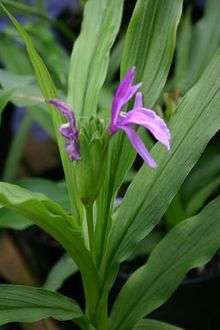 Roscoea capitata Sm.
Roscoea capitata Sm.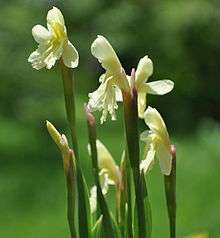 Roscoea cautleyoides Gagnep.
Roscoea cautleyoides Gagnep. Roscoea humeana Balf.f. & W.W.Sm.
Roscoea humeana Balf.f. & W.W.Sm.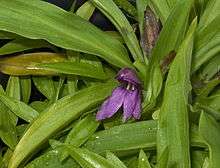 Roscoea kunmingensis S.Q.Tong
Roscoea kunmingensis S.Q.Tong Roscoea nepalensis Cowley
Roscoea nepalensis Cowley Roscoea purpurea Sm.
Roscoea purpurea Sm.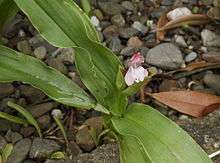 Roscoea scillifolia (Gagnep.) Cowley
Roscoea scillifolia (Gagnep.) Cowley Roscoea tumjensis Cowley
Roscoea tumjensis Cowley Roscoea wardii Cowley
Roscoea wardii Cowley
Cultivation

Some Roscoea species and cultivars are grown in gardens, particularly rock gardens, as ornamental plants. Coming from monsoon regions, they require moisture in the summer but relatively dry conditions in winter. A moisture-retaining but well-drained soil is recommended, with a mulch of a material such as bark. They vary in their tolerance of sun exposure, most requiring shade for at least part of the day. In a Royal Horticultural Society trial, R. ganeshensis and R. purpurea f. rubra were the most harmed by too much sun; R. cautleyoides, R. × beesiana and R. scillifolia the most resistant. In cultivation they do not appear above ground until late spring or even early summer; thus if planted deeply enough, up to 15 cm (6 in), they escape frost damage in regions where subzero temperatures occur. Different species and cultivars then flower throughout late spring and summer into early autumn.[3][5]
They can be propagated by careful division in the autumn of the individual growth points produced by a large plant, or by seed. Seed should not be allowed to dry out. If sown immediately it is ripe, it will normally germinate in the following summer. Young plants should be potted on before the tuberous roots become too intertwined.[3][5]
RHS trial
From 2009 to 2011, the Royal Horticultural Society held a trial involving around 100 entries submitted by British and other European sources. All proved hardy (rating H4, i.e. hardy anywhere in the British Isles). The Award of Garden Merit was given to 17 entries:[5]
- R. auriculata and its cultivar 'Summer Deep Purple'
- R. × beesiana
- Cultivars of R. cautleyoides – 'Abigail Bloom', 'Himalaya', 'Jeffrey Thomas' and, subject to availability, 'Purple Queen'
- R. forrestii
- Forms and cultivars of R. humeana – f. humeana, f. lutea and f. tyria and, subject to availability, the cultivar 'Stephanie Bloom'
- A form and cultivars of R. purpurea – f. rubra, cultivars 'Dalai Lama', 'Helen Lamb' and 'Red Neck'
- Subject to availability, R. wardii
- Three cultivars whose origins are unclear – R. 'Hartington Raw Silk', R. 'Kew Beauty' (possibly a hybrid between R. cautleyoides and R. humeana) and, subject to availability, R. 'McBeath's Pink'.
Notes
- ↑ Some sources use the term "staminode" only for the lateral staminodes. See e.g. Wilford (2012, p. 79).
References
- 1 2 3 4 5 WCSP (2011), World Checklist of Selected Plant Families, Royal Botanic Gardens, Kew, retrieved 2011-10-01, search for "Roscoea"
- 1 2 3 4 Wu, Delin; Larsen, Kai, "Roscoea", http://www.efloras.org/florataxon.aspx?flora_id=2&taxon_id=128752, retrieved 2011-10-01 Missing or empty
|title=(help), in Wu, Zhengyi; Raven, Peter H. & Hong, Deyuan, eds. (1994 onwards), Flora of China, Beijing; St. Louis: Science Press; Missouri Botanical Garden, retrieved 2011-10-01 Check date values in:|date=(help) - 1 2 3 Wilford, Richard (1999), "Roscoeas for the rock garden", Quarterly Bulletin of the Alpine Garden Society, 67 (1): 93–101
- 1 2 3 4 5 Ngamriabsakul, C.; Newman, M.F. & Cronk, Q.C.B. (2000), "Phylogeny and disjunction in Roscoea (Zingiberaceae )" (PDF), Edinburgh Journal of Botany, 57 (1): 39–61, doi:10.1017/s0960428600000032, retrieved 2011-10-03
- 1 2 3 4 Wilford, Richard (2012), "Roscoea on trial", The Plantsman (New Series), 11 (2): 78–85
- ↑ Botanica: The Illustrated A-Z of Over 10,000 Garden Plants and How to Cultivate Them, Köln: Könemann, 2004, ISBN 978-3-8331-1253-9, p. 801
- ↑ Wu, Delin; Larsen, Kai, "Zingiberaceae", http://www.efloras.org/florataxon.aspx?flora_id=2&taxon_id=10960, retrieved 2011-10-01 Missing or empty
|title=(help), in Wu et al. - 1 2 Zhang, Zhi-Qiang & Li, Qing-Jun (2008), "Autonomous Selfing Provides Reproductive Assurance in an Alpine Ginger Roscoea schneideriana (Zingiberaceae)", Annals of Botany, 102 (4): 531–538, PMC 2701783
 , PMID 18682439, doi:10.1093/aob/mcn136
, PMID 18682439, doi:10.1093/aob/mcn136 - ↑ Ngamriabsakul, C. (2005), "Morphological study of the versatile anther group in the tribe Zingibereae (Zingiberaceae)" (PDF), Walailak Journal of Science and Technology, 2: 11–12, retrieved 2011-10-22, p. 18
- 1 2 Zhang, Z.‐Q.; Kress, W.J.; Xie, W.‐J.; Ren, P.‐Y.; Gao, J.-Y. & Li, Q.-J. (2011), "Reproductive biology of two Himalayan alpine gingers (Roscoea spp., Zingiberaceae) in China: pollination syndrome and compensatory floral mechanisms", Plant Biology, 13 (4): 582–589, doi:10.1111/j.1438-8677.2010.00423.x
- ↑ Hyam, R. & Pankhurst, R.J. (1995), Plants and their names : a concise dictionary, Oxford: Oxford University Press, ISBN 978-0-19-866189-4, p. 435
- ↑ Cowley 1982, p. 748
- ↑ Kress, W. John; Prince, Linda M. & Williams, Kyle J. (2002), "The phylogeny and a new classification of the gingers (Zingiberaceae): evidence from molecular data", American Journal of Botany, 89 (10): 1682–1696, PMID 21665595, doi:10.3732/ajb.89.10.1682
- 1 2 Mao, A. A. & Bhaumik, M. (2007, published 2008), "Roscoea ngainoi (Zingiberaceae) sp. nov. from Manipur, India", Nordic Journal of Botany, 25 (5–6): 299–302, doi:10.1111/j.0107-055X.2008.00186.x Check date values in:
|date=(help) - 1 2 3 Zhao, Jian-Li; Xia, Yong-Mei; Cannon, Charles H.; Kress, W. John; Li, Qing-Jun (2016). "Evolutionary diversification of alpine ginger reflects the early uplift of the Himalayan–Tibetan Plateau and rapid extrusion of Indochina". Gondwana Research. 32: 232–241. doi:10.1016/j.gr.2015.02.004.
- ↑ Cowley 1982
- ↑ Ngamriabsakul, C. & Newman, M.F. (2000), "A New Species of Roscoea Sm. (Zingiberaceae) from Bhutan and Southern Tibet" (PDF), Edinburgh Journal of Botany, 57 (02): 271–278, doi:10.1017/s0960428600000202, retrieved 2011-10-04
Bibliography
- Cowley, E.J. (1982), "A revision of Roscoea (Zingiberaceae)", Kew Bulletin, 36 (4): 747–777, JSTOR 4117918, doi:10.2307/4117918
- Cowley, Jill (2007), The genus Roscoea, Royal Botanic Gardens, Kew, ISBN 978-1-84246-134-1
External links
| Wikimedia Commons has media related to Roscoea. |
- Images of most of the species of Roscoea in cultivation
- Images of Roscoea species, some taken in the wild